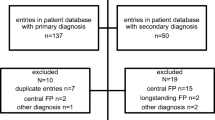Abstract
We assessed the prevalence of Lyme neuroborreliosis in children with acute facial nerve palsy in a Lyme-endemic region and patient characteristics associated with this. All children visiting one of three participating hospitals between January 2010 and December 2016 were included in the study. Of 104 children referred to the hospital with facial nerve palsy, 43% had Lyme neuroborreliosis and 57% idiopathic facial palsy. Characteristics significantly associated with Lyme neuroborreliosis were headache (55% versus 18%), meningeal irritation (21% versus 5%), presentation in summer months (69% versus 37%), and a previous tick bite (33% versus 7%).

Similar content being viewed by others
Data and code availability
Data and code will be made available upon reasonable request.
References
Tveitnes D, Øymar K, Natås O (2007) Acute facial nerve palsy in children: how often is it Lyme borreliosis? Scand J Infect Dis 39:425–431. https://doi.org/10.1080/00365540601105764
Jenke AC, Stoek LM, Zilbauer M, Wirth S, Borusiak P (2011) Facial palsy: etiology, outcome and management in children. Eur J Paediatr Neurol 15:209–213. https://doi.org/10.1016/j.ejpn.2010.11.004
van Burgel ND, Brandenburg A, Gerritsen HJ, Kroes ACM, van Dam AP (2011) High sensitivity and specificity of the C6-peptide ELISA on cerebrospinal fluid in Lyme neuroborreliosis patients. Clin Microbiol Infect 17:1495–1500. https://doi.org/10.1111/j.1469-0691.2011.03459.x
Marangoni A, Moroni A, Accardo S, Cevenini R (2008) Borrelia burgdorferi VlsE antigen for the serological diagnosis of Lyme borreliosis. Eur J Clin Microbiol Infect Dis 27:349–354. https://doi.org/10.1007/s10096-007-0445-7
Mikrogen Diagnostik. RecomLine Borrelia, Instructions for use. Available at: https://www.mikrogen.de/english/products/productoverview/weitereinfo/borrelia-igg-1.html. Accessed 1 Mar 2021
OXOID. IDEIA Lyme Neuroborreliosis. Available at: https://www.thermofisher.com/search/results?persona=DocSupport&refinementSearch=true&query=Manuals+&+Protocols&navId=4294959596&refinementQuery=IDEIA+Lyme+neuroborreliosis. Accessed 1 Mar 2021
Christen HJ, Bartlau H, Hanefeld F, Eiffert H, Thomssen R (1990) Peripheral facial palsy in childhood - Lyme borreliosis to be suspected unless proven otherwise. Acta Paediatr Scand 79:1219–1224. https://doi.org/10.1111/j.1651-2227.1990.tb11413.x
Feder HM Jr (2008) Lyme disease in children. Infect Dis Clin N Am 22:315–326
Nigrovic LE, Neville DN, Balamuth F, Bennett JE, Levas MN, Garro AC (2019) A minority of children diagnosed with Lyme disease recall a preceding tick bite. Ticks Tick Borne Dis 10:694–696. https://doi.org/10.1016/j.ttbdis.2019.02.015
Mygland Å, Ljøstad U, Fingerle V, Rupprecht T, Schmutzhard E, Steiner I (2010) EFNS guidelines on the diagnosis and management of European lyme neuroborreliosis. Eur J Neurol 17:8–16. https://doi.org/10.1111/j.1468-1331.2009.02862.x
Dutch Quality Institute for Health Care (CBO) (2013) Dutch guideline for Lyme disease. Utrecht. Available at: https://www.rivm.nl/documenten/cbo-richtlijn-lymeziekte-juli-2013. Accessed 1 Mar 2021
Stanek G, Wormser GP, Gray J, Strle F (2012) Lyme borreliosis. Lancet 379:461–473. https://doi.org/10.1016/S0140-6736(11)60103-7
Cerar T, Ogrinc K, Strle F, Ružić-Sabljić E (2010) Humoral immune responses in patients with lyme neuroborreliosis. Clin Vaccine Immunol 17:645–650. https://doi.org/10.1128/CVI.00341-09
Aguero-Rosenfeld ME, Wang G, Schwartz I, Wormser GP (2005) Diagnosis of lyme borreliosis. Clin Microbiol Rev 18:484–509. https://doi.org/10.1128/CMR.18.3.484-509.2005
Hytönen J, Kortela E, Waris M, Puustinen J, Salo J, Oksi J (2014) CXCL13 and neopterin concentrations in cerebrospinal fluid of patients with Lyme neuroborreliosis and other diseases that cause neuroinflammation. J Neuroinflammation 11:103. https://doi.org/10.1186/1742-2094-11-103
Knudtzen FC, Nilsson AC, Hovius JW, Skarphedinsson S (2020) The predictive value of CXCL13 in suspected Lyme neuroborreliosis: a retrospective cross-sectional study. Eur J Clin Microbiol Infect Dis 39:1461–1470. https://doi.org/10.1007/s10096-020-03861-4
Van Burgel ND, Bakels F, Kroes ACM, Van Dam AP (2011) Discriminating Lyme neuroborreliosis from other neuroinflammatory diseases by levels of CXCL13 in cerebrospinal fluid. J Clin Microbiol 49:2027–2030. https://doi.org/10.1128/JCM.00084-11
Skogman BH, Lager M, Brudin L, Jenmalm MC, Tjernberg I, Henningsson AJ (2020) Cytokines and chemokines in cerebrospinal fluid in relation to diagnosis, clinical presentation and recovery in children being evaluated for Lyme neuroborreliosis. Ticks Tick Borne Dis 11:101390. https://doi.org/10.1016/j.ttbdis.2020.101390
Author information
Authors and Affiliations
Corresponding author
Ethics declarations
Ethics approval and consent to participate
As data were collected as part of usual care, the study did not fall under the scope of the Dutch Medical Research Involving Human Subjects Act and no informed consent was required.
Consent for publication
Not applicable.
Conflicts of interest
The authors declare no conflicts of interest.
Additional information
Publisher’s note
Springer Nature remains neutral with regard to jurisdictional claims in published maps and institutional affiliations.
Rights and permissions
About this article
Cite this article
Bruinsma, R.A., Smulders, C.A., Vermeeren, Y.M. et al. Acute facial nerve palsy in children in a Lyme disease–endemic area in the Netherlands. Eur J Clin Microbiol Infect Dis 40, 2455–2458 (2021). https://doi.org/10.1007/s10096-021-04273-8
Received:
Accepted:
Published:
Issue Date:
DOI: https://doi.org/10.1007/s10096-021-04273-8




